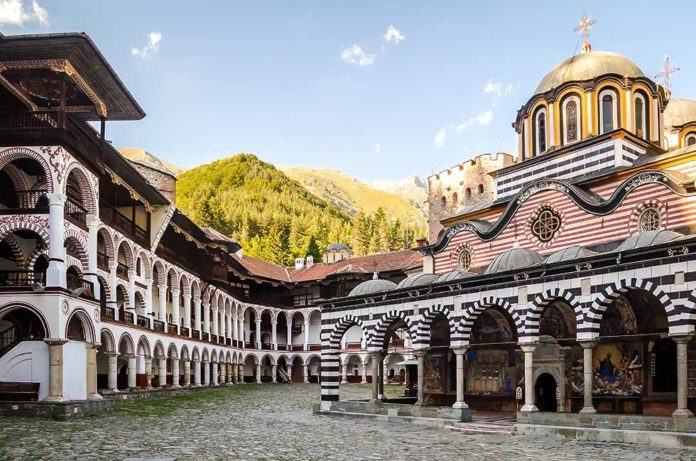Discovering Bulgaria’s monastery heritage takes you to the core of the country’s spiritual essence. These hallowed monasteries have served as beacons of faith, resilience, cultural identity, and artistic excellence throughout the ages.
Pre-10th Century: The First Foundations
Our journey begins in the tranquil Thracian plains, where the roots of monastic life in Bulgaria take hold. The St. Athanasius Monastery, established under the reign of Tsar Ivan Rilski in the 5th century, is the country’s oldest. It was located near today’s city of Plovdiv and was an early beacon of Christian faith during Byzantine rule.
10th – 13th Century: The Emergence of Architectural Grandeur
A short journey northwest towards the rugged Rila Mountains leads us to the largest and most famed of Bulgaria’s monastic complexes, the Rila Monastery. Founded in 927 AD by the hermit, St. John of Rila, it is a testament to Bulgaria’s medieval architectural genius.
On Sofia’s outskirts, another spiritual gem awaits discovery. The Boyana Monastery, founded in 1018, is renowned for its 13th-century frescoes, a vivid amalgamation of Byzantine and local artistic traditions.
14th – 15th Century: Monastic Expansion Amidst Turmoil
Despite the political instability of the 14th century, monastic life persisted. The Ivanovo Monastery, a marvel carved into the Rusenski Lom Nature Park cliffs near Ruse, emerged around 1200. Its unique cave churches, set against the scenic backdrop of a natural canyon, are home to some of the most exceptional medieval art.
On the Black Sea coast, near the bustling city of Varna, the Aladzha Monastery presents another marvel of monastic life. Nestled within a striking limestone cliff, its catacombs and frescoes tell tales of early Christian hermit life.
Further south, in the secluded woods near the village of Voden in the Strandzha Mountains, the Parorian Monastery rose to prominence as a spiritual and cultural center of Hesychasm. Founded in the 14th century and supported by Tsar Ivan Alexander, it became home to the revered monk Gregory of Sinai, attracting disciples across the Balkans. Today, its remote ruins whisper stories of spiritual devotion and resilience amidst nature’s embrace.
Similarly rooted in medieval tradition, the Kuklen Monastery near Plovdiv—often referred to as the “monastery of miracles”—was established during this same period and is a testament to the endurance of Orthodox faith through centuries of upheaval.
16th – 18th Century: A Testament of Resilience
The Ottoman rule that darkened the 16th century was not without bright sparks of resilience. Hidden in the Balkan Mountains near Gabrovo, the Dryanovo Monastery, in its present appearance, rose in 1515. It served as a sanctuary of spiritual defiance during the April Uprising of 1876.
The Glozhene Monastery perched atop the vertical cliffs of the Central Balkan near Teteven, tells a similar tale of strength. Its isolation has helped it endure as a silent witness to centuries of Bulgarian history.
To the south, near Asenovgrad, the Bachkovo Monastery stands as another testament to endurance under Ottoman rule, founded by a Georgian military commander in 1083.
19th Century Monasteries: The Revival Era
The Bulgarian National Revival saw a rebirth of culture and spirituality. The Transfiguration Monastery, situated on the banks of the Yantra River near Veliko Tarnovo, exemplifies this resurgence. Rebuilt in 1825 after multiple Ottoman attacks, its murals, painted by Zahari Zograph, breathe life into the tales of faith and rebellion.
Nestled in the Stara Planina mountain range near Kazanlak, the Shipka Monastery was established in 1885 to commemorate Bulgaria’s liberation. Its gold-domed structure has become a beacon of national pride.
Simultaneously, the Rozhen Monastery, tucked away in the Pirin Mountains near Melnik, experienced its rebirth and embodied the essence of the Revival era.
20th Century: Merging Tradition with Modernity
The 20th century saw Bulgarian monastic tradition merge with modern architectural trends. The St. George Monastery, near the Black Sea city of Pomorie, founded in 1926, manifests this synthesis.
Southwards near Asenovgrad, the Arapovski Monastery, erected in 1856, showcases a blend of spirituality, historical legacy, and Bulgarian National Revival-style architecture.
In the north, the Troyan Monastery, dating back to the 16th century, played a pivotal role in the 1876 April Uprising. Its location near Troyan town and its unique three-part iconostasis make it a must-visit landmark.
21st Century: Preserving Monasteries Spiritual Heritage
Bulgaria’s monastic heritage continues to thrive in the 21st century. Near the village of Kosharitsa, the recently constructed St. John the Baptist Monastery continues the monastic traditions.
In Pomorie, a town on the Black Sea coast, the Monastery of St. George the Victorious reflects modern monastic architecture and carries its legacy into the new century.
Bulgaria’s monasteries chronicle the nation’s past and present, from the Thracian plains to the Black Sea coast and from Sofia’s outskirts to the Balkan and Pirin Mountains. They are historical and cultural landmarks and spiritual centers carrying a rich heritage and reflecting the resilient Bulgarian spirit.



